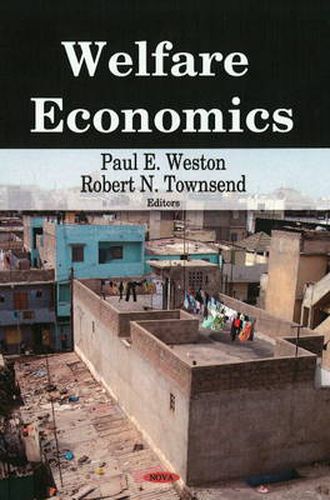Readings Newsletter
Become a Readings Member to make your shopping experience even easier.
Sign in or sign up for free!
You’re not far away from qualifying for FREE standard shipping within Australia
You’ve qualified for FREE standard shipping within Australia
The cart is loading…






Welfare economics is a branch of economics that uses microeconomic techniques to simultaneously determine allocative efficiency within an economy and the income distribution associated with it. It analyses social welfare, however measured, in terms of economic activities of the individuals that comprise the theoretical society considered. As such, individuals, with associated economic activities, are the basic units for aggregating to social welfare, whether of a group, a community, or a society, and there is no social welfare apart from the welfare associated with its individual units. Here, ‘welfare’ in its most general sense refers to well-being. Welfare economics typically takes individual preferences as given and stipulates a welfare improvement in Pareto efficiency terms from social state A to social state B if at least one person prefers B and no one else opposes it. There is no requirement of a unique quantitative measure of the welfare improvement implied by this. Another aspect of welfare treats income/goods distribution, including equality, as a further dimension of welfare. Social welfare refers to the overall welfare of society. With sufficiently strong assumptions, it can be specified as the summation of the welfare of all the individuals in the society. Welfare may be measured either cardinally in terms of utils or dollars, or measured ordinally in terms of Pareto efficiency. The cardinal method in utils is seldom used in pure theory today because of aggregation problems that make the meaning of the method doubtful, except on widely challenged underlying assumptions. In applied welfare economics, such as in cost-benefit analysis, money-value estimates are often used, particularly where income-distribution effects are factored into the analysis or seem unlikely to undercut the analysis. It is conventional to distinguish two sides to welfare economics: economic efficiency and income distribution. Economic efficiency is largely positive and deals with the size of the pie . Income distribution is much more normative and deals with dividing up the pie . Other classifying terms or problems in welfare economics include externalities, equity, justice, inequality, and altruism. This book presents the latest research in the field from around the world.
$9.00 standard shipping within Australia
FREE standard shipping within Australia for orders over $100.00
Express & International shipping calculated at checkout
Welfare economics is a branch of economics that uses microeconomic techniques to simultaneously determine allocative efficiency within an economy and the income distribution associated with it. It analyses social welfare, however measured, in terms of economic activities of the individuals that comprise the theoretical society considered. As such, individuals, with associated economic activities, are the basic units for aggregating to social welfare, whether of a group, a community, or a society, and there is no social welfare apart from the welfare associated with its individual units. Here, ‘welfare’ in its most general sense refers to well-being. Welfare economics typically takes individual preferences as given and stipulates a welfare improvement in Pareto efficiency terms from social state A to social state B if at least one person prefers B and no one else opposes it. There is no requirement of a unique quantitative measure of the welfare improvement implied by this. Another aspect of welfare treats income/goods distribution, including equality, as a further dimension of welfare. Social welfare refers to the overall welfare of society. With sufficiently strong assumptions, it can be specified as the summation of the welfare of all the individuals in the society. Welfare may be measured either cardinally in terms of utils or dollars, or measured ordinally in terms of Pareto efficiency. The cardinal method in utils is seldom used in pure theory today because of aggregation problems that make the meaning of the method doubtful, except on widely challenged underlying assumptions. In applied welfare economics, such as in cost-benefit analysis, money-value estimates are often used, particularly where income-distribution effects are factored into the analysis or seem unlikely to undercut the analysis. It is conventional to distinguish two sides to welfare economics: economic efficiency and income distribution. Economic efficiency is largely positive and deals with the size of the pie . Income distribution is much more normative and deals with dividing up the pie . Other classifying terms or problems in welfare economics include externalities, equity, justice, inequality, and altruism. This book presents the latest research in the field from around the world.